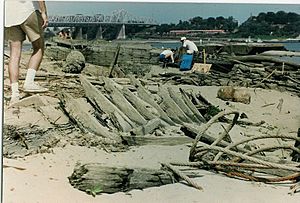1988–1990 North American drought facts for kids


The 1988–1990 North American drought was one of the worst dry periods in the history of the United States. This drought started in 1988 and lasted into 1989 and 1990 in some areas. It caused a huge amount of damage, about $60 billion (which is $148 billion 2025 USD today).
During this time, there were many dust storms, especially in the Midwestern United States. Some were so bad that schools in South Dakota had to close in early 1988. Many places also had record-breaking dry spells. For example, Milwaukee went 55 days without any rain. The summer of 1988 also saw two very hot heat waves, similar to those in the 1930s. These heatwaves sadly caused the deaths of 4,800 to 17,000 people in the United States. The drought also led to many wildfires in western North America, including the big Yellowstone fires of 1988.
At its worst, the drought covered 45% of the United States. This was less than the Dust Bowl of the 1930s, which covered 70%. However, the 1988–1990 drought was the most expensive drought in U.S. history. It was also one of the costliest natural disasters ever in the United States. In Canada, the drought caused about $1.8 billion (in 1988 Canadian dollars) in losses.
How the Drought Started
The western United States had a long dry period in the late 1980s. California experienced one of its longest droughts from late 1986 to late 1992. The situation became much worse in 1988 when many other parts of the United States also faced severe drought.
In California, the six-year drought finally ended in late 1992. This was likely due to a big El Niño event in the Pacific Ocean. The eruption of Mount Pinatubo in June 1991 also probably caused unusually heavy and long-lasting rains.
Another factor that made the damage worse was farming land that wasn't very good for crops. Also, people pumped too much groundwater, which is water found underground, almost emptying it.
Impact and Damage
The 1988 drought was the worst drought since the Dust Bowl, which happened over 50 years earlier. The total damage in the United States was estimated to be between $80 billion and almost $120 billion (when adjusted for inflation to 2008). For example, the state of Minnesota alone lost $1.2 billion in crops. The damage from this drought was as bad as that from major hurricanes like Hurricane Andrew in 1992 and Hurricane Katrina in 2005. Canada also lost about $1.8 billion (in 1988 Canadian dollars) because of the drought.
After a milder drought the year before, the 1988–1989 drought hit many parts of the U.S. This included the Mid-Atlantic states, the southeastern United States, the midwestern United States, the northern Great Plains, and the western United States. The heatwaves that came with the drought killed over 5,000 Americans and many farm animals across the country.
The drought destroyed crops almost everywhere. Lawns turned brown, and many cities had to limit how much water people could use. In September 1988, Hurricane Gilbert brought over four inches (100 mm) of much-needed rain to parts of the Midwest. It weakened as it moved north, but still spread rain as far as the Great Lakes. In some areas, Hurricane Gilbert helped end the drought. However, other places were still very dry, and it took a bigger change in weather patterns to truly ease the drought's effects. By this point, most of the damage to farms was already done, which led to very high prices for food.
The wildfires in Yellowstone National Park burned about 793,880 acres (3,213 km²) of land. This greatly changed the park's landscape. The severe drought continued in the Upper Midwest and northern Great Plains states during 1989. It didn't officially end until 1990. Dry conditions also affected Iowa, Illinois, Missouri, parts of Nebraska, Minnesota, Kansas, and large areas of Colorado in 1989. Some parts of Canada were also affected.
Starting in the spring, a strong wind pattern brought hot, dry air into the middle of the continent from the desert southwest. Normally, warm and humid air from the Gulf of Mexico moves into these areas. This unusual pattern caused the extremely high temperatures.
See also
 In Spanish: Sequía en América del Norte de 1988-1990 para niños
In Spanish: Sequía en América del Norte de 1988-1990 para niños
- 1980 United States heat wave

